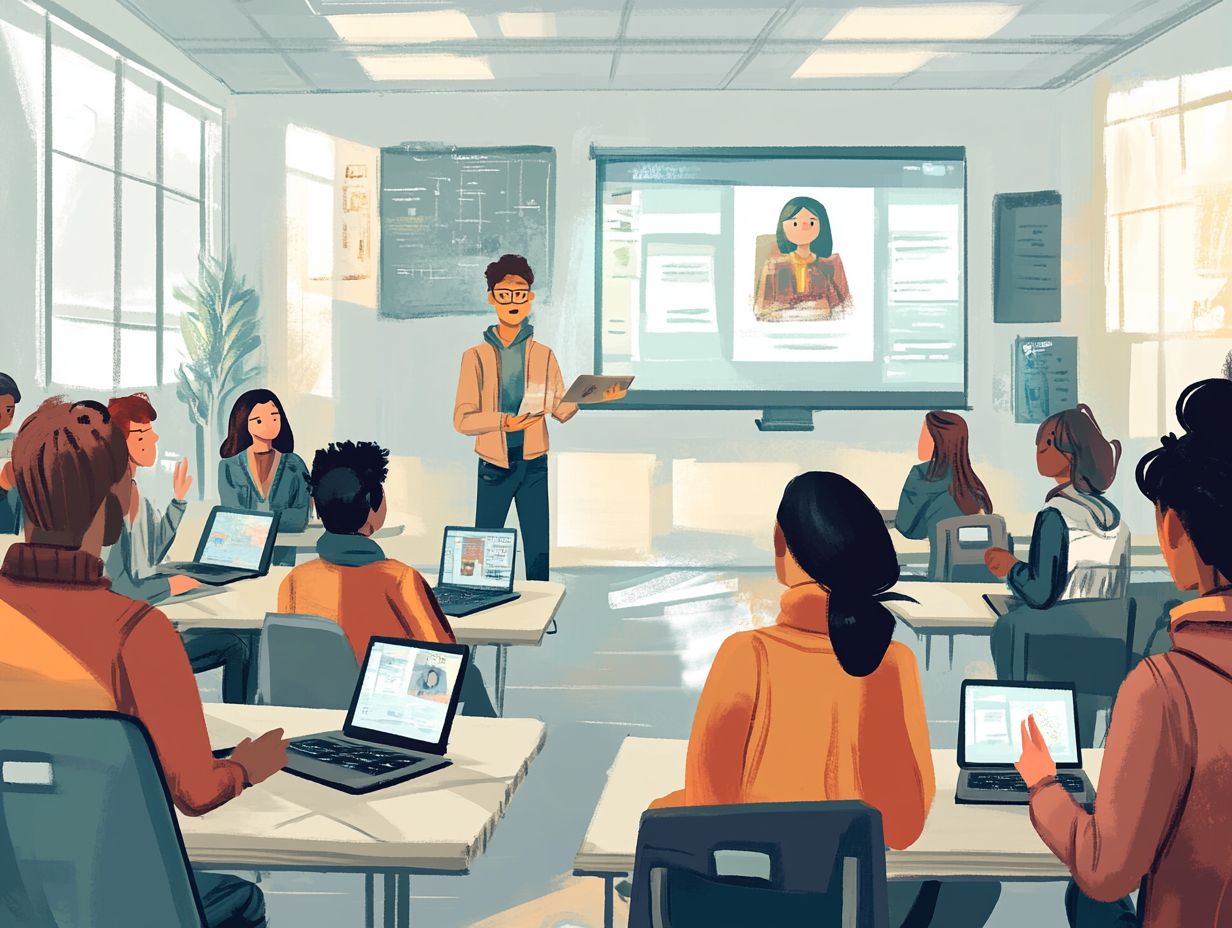The Impact of Technology on Associate Degree Learning
In today s rapidly evolving educational landscape, associate degrees have become a popular choice for many aspiring students. Explore these vital insights now to supercharge your educational journey!
This article delves into what an associate degree truly entails, along with the benefits and challenges that come with pursuing one. You ll discover how technology is reshaping learning experiences, enhancing accessibility, and influencing student success. While technology opens doors to exciting opportunities, it also brings challenges that require thoughtful consideration.
Join the journey as we explore the evolving role of technology in associate degree education.
Contents
- Key Takeaways:
- Overview of Associate Degree Learning
- The Role of Technology in Associate Degree Learning
- Impact of Technology on Student Success
- Tackling Challenges in Tech Integration
- Frequently Asked Questions
- How has technology impacted the learning experience for associate degree students?
- What are some specific ways that technology has improved the learning process for associate degree students?
- Are there any potential drawbacks to the increased use of technology in associate degree learning?
- How has the COVID-19 pandemic affected the impact of technology on associate degree learning?
- What skills do associate degree students develop through their use of technology?
- How can instructors and institutions ensure that technology effectively supports associate degree learning?
Key Takeaways:

- Technology has greatly improved access and flexibility for associate degree students, allowing them to balance work, family, and education more easily.
- Incorporating technology in learning enhances student success by improving retention and providing a more engaging learning experience.
- As technology continues to play a larger role in education, it is important to address concerns such as equity and accessibility, and work towards overcoming technological barriers to ensure equal opportunities for all students.
Overview of Associate Degree Learning
The overview of associate degree learning encapsulates the essential elements that define this educational pathway. It highlights its significance in today s educational landscape.
An associate degree acts as a vital bridge between high school and higher education, providing foundational skills necessary for both academic and professional success. It typically blends general education with specialized courses, nurturing critical thinking, enhancing communication skills, and imparting practical knowledge crucial for preparing you for the workforce.
What is an Associate Degree?
An associate degree is a valuable post-secondary academic qualification awarded by higher education institutions, typically after two years of full-time study. This degree serves as both a stepping stone toward a bachelor’s degree and a standalone credential that enhances employability.
You ll find two main types of associate degrees:
- The Associate of Arts (AA), which often focuses on liberal arts and humanities.
- The Associate of Science (AS), which emphasizes technical and scientific fields.
The curriculum combines general education courses with specialized subjects, fostering essential academic performance skills and digital literacy both crucial in today s tech-driven job market. Employers want candidates who understand technology and have good soft skills. Holding an associate degree can significantly boost your job prospects and unlock a variety of career paths.
Benefits and Challenges of Pursuing an Associate Degree
Pursuing an associate degree offers a mix of benefits and challenges that you must skillfully navigate to achieve academic success, especially in today s evolving educational landscape.
This academic pathway opens doors to a wealth of job opportunities, allowing you to step into the workforce swiftly and with a competitive advantage. The affordability of community colleges makes higher education within reach, particularly if financial constraints are a concern for you.
You might feel challenged by the need to adapt to online or hybrid learning environments, which demand a certain level of comfort with using technology and self-discipline. However, you can take advantage of personalized learning experiences and a rich array of educational resources, highlighting the crucial role that teachers play in fostering engagement and supporting you on your academic journey.
The Role of Technology in Associate Degree Learning
The role of technology in associate degree learning has revolutionized educational methodologies, creating interactive and engaging learning environments that cater to the diverse needs of students. For more insights, explore understanding online learning platforms for associate degrees.
How Technology is Changing the Landscape of Education

Technology is reshaping education, driving digital transformation and introducing tools that enhance collaboration and engagement.
Advancements like virtual and augmented reality create immersive experiences. You can interact with concepts in ways that make complex subjects feel accessible.
The rise of Educational Technology (EdTech) supports this shift, providing tools that blend traditional classroom settings with digital elements. This promotes hybrid learning models that cater to your needs.
Through these innovative approaches, educators can help you cultivate critical thinking skills. They encourage you to analyze, evaluate, and create instead of merely memorizing information.
As a result, your learning outcomes significantly improve, equipping you with the essential competencies needed for success in today s world.
Advantages and Disadvantages of Technology in Learning
The advantages and disadvantages of technology in learning reveal the intricate balance involved in integrating digital tools into educational settings. This significantly influences your performance and engagement as a student.
On one hand, tech-enhanced education brings remarkable benefits. You gain access to a vast array of resources, enabling you to delve into knowledge that goes far beyond traditional textbooks.
Personalized learning experiences allow you to progress at your own pace, catering to your unique needs and preferences.
However, this digital shift also presents critical concerns, particularly regarding technology equity and the pervasive digital divide. Not every student has equal access to devices and reliable internet connectivity, which can intensify existing educational challenges.
Therefore, it’s essential to consider how these disparities might affect your overall performance and engagement in this evolving academic landscape.
Impact of Technology on Student Success
Technology is revolutionizing student success in amazing ways! It reshapes learning outcomes and creates opportunities for enhanced engagement.
Through remote learning and virtual classrooms, you embrace a more interactive and flexible educational experience.
Improving Access and Flexibility
Improving access and flexibility in education stands out as a remarkable advantage of technology. It enables you to engage with online education and explore diverse resources at your own pace.
This shift not only caters to different learning styles but also gives you the power to take ownership of your educational journey.
Various tools, such as interactive simulations, online discussion boards, and adaptive learning platforms, can ignite your motivation. They provide personalized pathways tailored to your unique needs.
For example, visual aids and gamified learning experiences make lessons far more engaging. Gamification uses game-like elements in learning to make it more engaging.
Resources like digital textbooks and educational apps afford you the convenience of accessing information anytime and anywhere. This fosters a collaborative learning environment that encourages meaningful peer interaction and support.
Enhancing Learning and Retention
Enhancing your learning and retention is at the forefront of modern educational practices. Technology plays a crucial role in shaping instructional design and fostering collaborative learning environments.
Innovative strategies like gamification, interactive simulations, and digital storytelling captivate you while bolstering your ability to remember and apply knowledge effectively.
Tools such as learning management systems (LMS) and collaborative platforms allow for real-time feedback and peer interaction. This cultivates a sense of community and teamwork among you and your fellow learners.
By integrating multimedia resources, educators can address diverse learning styles, ensuring you benefit from the material in a way that resonates with you.
Analytics from educational technology empower instructors to customize their approaches. They can pinpoint areas where you might struggle and deliver targeted support to enhance your overall educational outcomes.
Tackling Challenges in Tech Integration

Addressing concerns and challenges in the integration of technology within education is crucial for ensuring that you, as an educator or stakeholder, can foster an environment where all students truly benefit from modern learning approaches.
By navigating these complexities thoughtfully, you help create equitable opportunities for every learner to thrive in a digitally enhanced educational landscape.
Ensuring Equity and Accessibility
Ensuring equity and accessibility in education is crucial for creating a welcoming space where you can truly thrive, especially in this era of digital learning.
In today s fast-paced, technology-driven landscape, we must acknowledge that not all learners have equal access to digital tools and resources. This disparity can significantly hinder your ability to engage with the curriculum and acquire the vital skills necessary for future success.
As educational institutions work to bridge this gap, they must prioritize initiatives that provide the necessary technology and improve digital skills among all students.
By addressing these concerns, schools can minimize the negative impacts of inequity, enabling you to fully participate in contemporary educational opportunities and level the playing field for your future advancement in an increasingly interconnected world.
Overcoming Technological Barriers
Overcoming technological barriers in education is essential for you to fully harness the benefits of technology integration and tackle the challenges faced by both students and teachers.
To reach this goal, it s imperative that institutions prioritize professional development opportunities that equip you, as an educator, with the essential competencies necessary for success.
By providing access to comprehensive training resources, you not only enhance your tech-savviness but also bolster your confidence in utilizing innovative tools effectively.
Creating a culture of collaboration among educators can significantly facilitate the sharing of best practices and strategies, allowing you to navigate the complexities of integrating new technologies into your teaching methodologies.
Emphasizing a commitment to continuous learning is vital, as it gives you the power to adapt to ever-evolving educational landscapes and ultimately enriches the learning experiences you offer to your students!
Frequently Asked Questions
How has technology impacted the learning experience for associate degree students?
Technology has had a significant impact on the learning experience for students in associate degree programs. It has made information more accessible, enhanced collaboration and communication, and provided new learning tools and methods, including insights into the role of technology in online bachelor’s degrees.
What are some specific ways that technology has improved the learning process for associate degree students?

Some specific ways that technology has improved the learning process for students in associate degree programs include the use of online course materials, interactive learning activities, virtual simulations, and online collaboration tools.
Are there any potential drawbacks to the increased use of technology in associate degree learning?
While technology has many benefits for associate degree learning, there may be some potential drawbacks as well. These include a potential increase in distractions and a lack of face-to-face interaction with instructors and peers.
How has the COVID-19 pandemic affected the impact of technology on associate degree learning?
The COVID-19 pandemic has greatly accelerated the use and importance of technology in associate degree learning. It has forced many institutions to shift to online learning and has highlighted the need for students to be proficient in using technology for their studies.
What skills do associate degree students develop through their use of technology?
Students in associate degree programs develop a variety of skills through their use of technology. These include digital literacy the ability to use technology effectively critical thinking, problem-solving, time management, and communication skills.
How can instructors and institutions ensure that technology effectively supports associate degree learning?
Instructors and institutions must provide proper training and support for students.
Regularly check how well the technology is working and make changes as needed.






